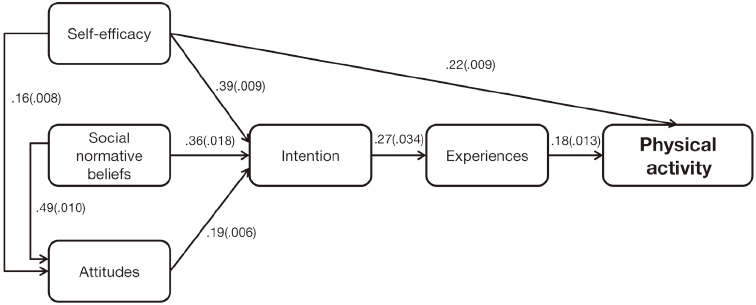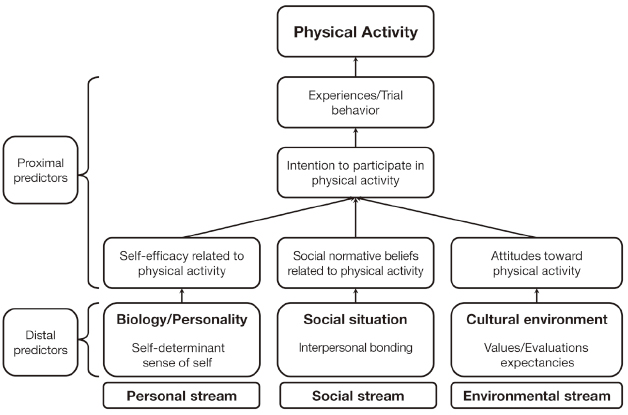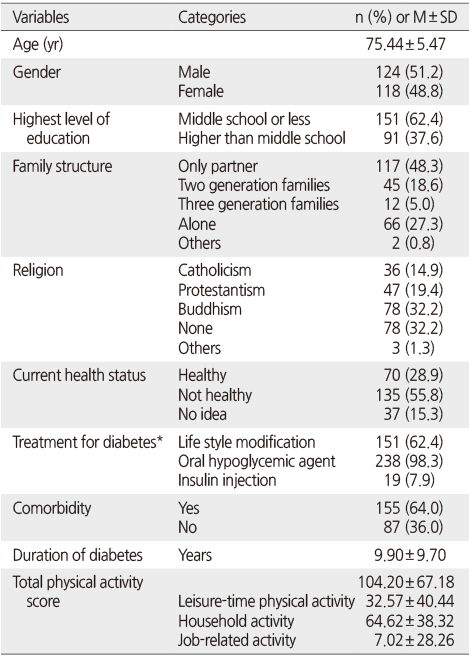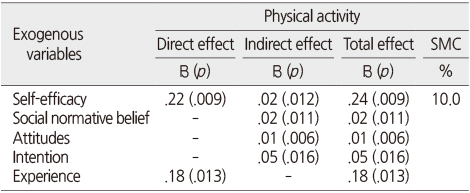Articles
- Page Path
- HOME > J Korean Acad Nurs > Volume 45(3); 2015 > Article
-
Original Article
- Factors Influencing Physical Activity among Community-dwelling Older Adults with Type 2 Diabetes: A Path Analysis
- Sun Joo Jang, Hyunju Park, Hyunjung Kim, Sun Ju Chang
-
Journal of Korean Academy of Nursing 2015;45(3):329-336.
DOI: https://doi.org/10.4040/jkan.2015.45.3.329
Published online: June 30, 2015
1College of Nursing, Eulji University, Daejeon, Korea.
2Department of Nursing, Kangwon National University, Chuncheon, Korea.
3Department of Nursing, Hallym University, Chuncheon, Korea.
4Department of Nursing Science, Chungbuk National University, Cheongju, Korea.
- Address reprint requests to: Chang, Sun Ju. Department of Nursing Science, Chungbuk National University, 1 Chungdae-ro, Seowon-gu, Cheongju 362-763, Korea. Tel: +82-43-249-1797, Fax: +82-43-269-1710, sjchang@chungbuk.ac.kr
© 2015 Korean Society of Nursing Science
This is an Open Access article distributed under the terms of the Creative Commons Attribution NoDerivs License. (http://creativecommons.org/licenses/by-nd/4.0/) If the original work is properly cited and retained without any modification or reproduction, it can be used and re-distributed in any format and medium.
Abstract
-
Purpose
- The purpose of the study was to identify factors influencing physical activity among community-dwelling older adults with type 2 diabetes. The study design was based on the Theory of Triadic Influence.
-
Methods
- A total of 242 older adults with type 2 diabetes participated in this study. Six variables related to physical activity in older adults, including self-efficacy, social normative belief, attitudes, intention, experience, and level of physical activity, were measured using reliable instruments. Data were analyzed using descriptive statistics, Pearson's correlation analyses, and a path analysis.
-
Results
- The mean physical activity score was 104.2, range from zero to 381.21. The path analysis showed that self-efficacy had the greatest total effect on physical activity. Also, experience had direct and total effects on physical activity as well as mediated the paths of social normative beliefs to attitudes and intention to physical activity. These factors accounted for 10% of the total variance, and the fit indices of the model satisfied the criteria of fitness.
-
Conclusion
- The findings of the study reveal the important role of self-efficacy and past experience in physical activity in older adults with type 2 diabetes.
- 1. Boulé NG, Haddad E, Kenny GP, Wells GA, Sigal RJ. Effects of exercise on glycemic control and body mass in type 2 diabetes mellitus: A meta-analysis of controlled clinical trials. JAMA. 2001;286(10):1218–1227.ArticlePubMed
- 2. Nocon M, Hiemann T, Müller-Riemenschneider F, Thalau F, Roll S, Willich SN. Association of physical activity with all-cause and cardiovascular mortality: A systematic review and meta-analysis. Eur J Cardiovasc Prev Rehabil. 2008;15(3):239–246. ArticlePubMedPDF
- 3. Sigal RJ, Kenny GP, Wasserman DH, Castaneda-Sceppa C, White RD. Physical activity/exercise and type 2 diabetes: A consensus statement from the American Diabetes Association. Diabetes Care. 2006;29(6):1433–1438. PubMed
- 4. Chodzko-Zajko WJ, Proctor DN, Fiatarone Singh MA, Minson CT, Nigg CR, Salem GJ, et al. American college of sports medicine position stand. Exercise and physical activity for older adults. Med Sci Sports Exerc. 2009;41(7):1510–1530. PubMed
- 5. Sinclair AJ, Conroy SP, Bayer AJ. Impact of diabetes on physical function in older people. Diabetes Care. 2008;31(2):233–235. ArticlePubMedPDF
- 6. Snowling NJ, Hopkins WG. Effects of different modes of exercise training on glucose control and risk factors for complications in type 2 diabetic patients: A meta-analysis. Diabetes Care. 2006;29(11):2518–2527. ArticlePubMedPDF
- 7. Kirkman MS, Briscoe VJ, Clark N, Florez H, Haas LB, Halter JB, et al. Diabetes in older adults. Diabetes Care. 2012;35(12):2650–2664. ArticlePubMedPMCPDF
- 8. Statistics Korea. Elderly statistics 2013 [Internet]. Daejeon, Author. 2013;cited 2014 November 1. Available from: http://kostat.go.kr/portal/korea/kor_nw/2/1/index.board?bmode=read&aSeq=308688
- 9. Ministry of Health & Welfare. Korea Centers for Disease Control & Prevention. Korea health statistics 2012: Korea national health and nutrition examination survey (KNHANES V-3). Seoul: Ministry of Health & Welfare; 2013.
- 10. Zhao G, Ford ES, Li C, Balluz LS. Physical activity in US older adults with diabetes mellitus: Prevalence and correlates of meeting physical activity recommendations. J Am Geriatr Soc. 2011;59(1):132–137. ArticlePubMed
- 11. Park IS, Kim R, Park MH, Kim CS, Kim YJ, Jung YJ. Factors influencing the exercise performance of elderly patients with diabetes. J Environ Sanit Eng. 2009;24(4):27–38.
- 12. Kang HY, Gu MO. A study on physical activity and related factors to physical activity for the elderly with diabetes mellitus. J Muscle Joint Health. 2012;19(1):57–70. Article
- 13. Sung KW. Relationship of daily activity and biochemical variables in the elderly with diabetes mellitus. J Korean Acad Nurs. 2011;41(2):182–190. ArticlePubMed
- 14. Hays LM, Clark DO. Correlates of physical activity in a sample of older adults with type 2 diabetes. Diabetes Care. 1999;22(5):706–712.ArticlePubMedPDF
- 15. World Health Organization. Physical activity and older adults: Recommended levels of physical activity for adults aged 65 and above [Internet]. Geneva, CH, Author. 2014;cited 2014 November 1. Available from: http://www.who.int/dietphysicalactivity/factsheet_olderadults/en/
- 16. Marquez DX, McAuley E. Social cognitive correlates of leisure time physical activity among Latinos. J Behav Med. 2006;29(3):281–289. ArticlePubMedPDF
- 17. Flay BR, Snyder F, Petraitis J. The theory of triadic influence. In: DiClemente RJ, Crosby RA, Kegler MC, editors. Emerging theories in health promotion practice and research. 2nd ed. San Francisco, CA: Jossey-Bass; 2009. p. 451–510.
- 18. Chang SJ, Choi S, Kim SA, Song M. Intervention strategies based on information-motivation-behavioral skills model for health behavior change: A systematic review. Asian Nurs Res. 2014;8(3):172–181. Article
- 19. Flay BR, Petraitis J. The theory of triadic influence: A new theory of health behavior with implications for preventive interventions. Adv Med Sociol. 1994;4:19–44.
- 20. Bell CC, Bhana A, Petersen I, McKay MM, Gibbons R, Bannon W, et al. Building protective factors to offset sexually risky behaviors among black youths: A randomized control trial. J Natl Med Assoc. 2008;100(8):936–944.ArticlePubMed
- 21. Flay BR, Graumlich S, Segawa E, Burns JL, Holliday MY. Effects of 2 prevention programs on high-risk behaviors among African American youth: A randomized trial. Arch Pediatr Adolesc Med. 2004;158(4):377–384. ArticlePubMedPMC
- 22. Stevens J. Applied multivariate statistics for the social sciences. 3rd ed. Mahwah, NJ: Lawrence Erlbaum Associates; 1996.
- 23. Francis JJ, Eccles MP, Johnston M, Walker A, Grimshaw J, Foy R, et al. Constructing questionnaires based on the theory of planned behavior: A manual for health services researchers. Centre for health services research: Quality of life and management of living resources. Newcastle upon Tyne, UK: University of Newcastle; 2004.
- 24. Resnick B, Jenkins LS. Testing the reliability and validity of the selfefficacy for exercise scale. Nurs Res. 2000;49(3):154–159.ArticlePubMed
- 25. Hagger MS, Chatzisarantis N, Biddle SJ. The influence of self-efficacy and past behaviour on the physical activity intentions of young people. J Sports Sci. 2001;19(9):711–725. ArticlePubMed
- 26. Washburn RA, Smith KW, Jette AM, Janney CA. The physical activity scale for the elderly (PASE): Development and evaluation. J Clin Epidemiol. 1993;46(2):153–162.ArticlePubMed
- 27. Choe MA, Kim J, Jeon MY, Chae YR. Evaluation of the Korean version of physical activity scale for the elderly (K-PASE). Korean J Women Health Nurs. 2010;16(1):47–59. ArticlePubMed
- 28. Logan SL, Gottlieb BH, Maitland SB, Meegan D, Spriet LL. The physical activity scale for the elderly (PASE) questionnaire; Does it predict physical health? Int J Environ Res Public Health. 2013;10(9):3967–3986. ArticlePubMedPMC
- 29. Bolszak S, Casartelli NC, Impellizzeri FM, Maffiuletti NA. Validity and reproducibility of the physical activity scale for the elderly (PASE) questionnaire for the measurement of the physical activity level in patients after total knee arthroplasty. BMC Musculoskelet Disord. 2014;15:46ArticlePubMedPMCPDF
- 30. Stiggelbout M, Hopman-Rock M, Crone M, Lechner L, van Mechelen W. Predicting older adults’ maintenance in exercise participation using an integrated social psychological model. Health Educ Res. 2006;21(1):1–14. ArticlePubMed
- 31. Maibach E, Murphy DA. Self-efficacy in health promotion research and practice: Conceptualization and measurement. Health Educ Res. 1995;10(1):37–50. Article
REFERENCES
Figure & Data
REFERENCES
Citations

- The Effect of Neighborhood Characteristics and Friends' Smoking Status on the Habitual Smoking Onset in Adolescents
You-Jung Choi, Gwang Suk Kim
Journal of Korean Academy of Nursing.2021; 51(1): 54. CrossRef - Factors influencing disordered eating behavior based on the theory of triadic influence
Jee Hee Han, Sun Ah Kim, Sue Kim, Jin Young Park
Perspectives in Psychiatric Care.2019; 55(3): 366. CrossRef - Effect of a Comprehensive Health Care Program on Blood Pressure, Blood Glucose, Body Composition, and Depression in Older Adults Living Alone: A Quasi-Experimental Pretest–Posttest Study
Eun Jeong Hwang, In Ok Sim
International Journal of Environmental Research and Public Health.2019; 17(1): 220. CrossRef - Factors Affecting Self-Care Behavior Levels among Elderly Patients with Type 2 Diabetes: A Quantile Regression Approach
Min Young Kim, Eun Ju Lee
Medicina.2019; 55(7): 340. CrossRef - Development of a scale to measure diabetes self‐management behaviors among olderKoreans with type 2 diabetes,based on the seven domains identified by theAmericanAssociation ofDiabetesEducators
Kyoungsan Seo, Misoon Song, Suyoung Choi, Se‐an Kim, Sun Ju Chang
Japan Journal of Nursing Science.2017; 14(2): 161. CrossRef - Factors Affecting the Physical Activity of Older Adults in the Community
Young Mi Kim, Soon Rim Suh
Journal of Korean Gerontological Nursing.2017; 19(2): 154. CrossRef - Regional Differences in Fall-Related Physical Fitness of the Elderly between Seoul, Korea and Gifu, Japan
Sohee Shin, Hyun-soo Kim, Soon-chang Sung, Tamotsu Yabumoto, Kosyo Kasuga, Kijeong Kim, Toshio Matsuoka
The Tohoku Journal of Experimental Medicine.2016; 238(3): 247. CrossRef - The Comparative Analysis of Health Risk Factor according to HbA1c Level of Elderly Women Dwelling in Jeonla Province - Blood Health Status, Food Habit and Nutrient Intake -
Se In Oh, Chung Shil Kwak, Mee Sook Lee
The Korean Journal of Food And Nutrition.2016; 29(3): 392. CrossRef


Figure 1
Figure 2
Demographic Characteristics and Level of Physical Activity (N=242)
*Multiple response.
Correlational Relationships between the Variables
Standardized Effects of Exogenous Variables on Physical Activity
SMC=Squared multiple correlation (R2).
*Multiple response.
SMC=Squared multiple correlation (R2).
 KSNS
KSNS
 E-SUBMISSION
E-SUBMISSION





 Cite
Cite

